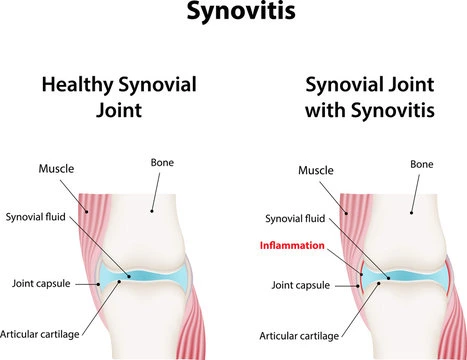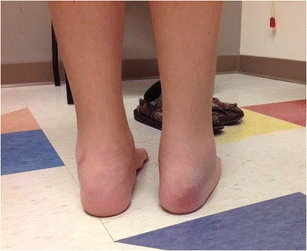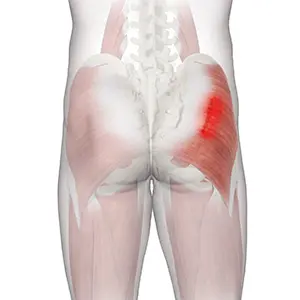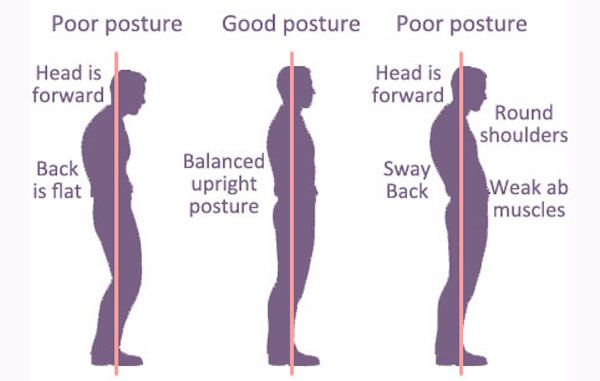Synovitis
What is Synovitis?
Synovitis is medical-term for inflammation in the synovium, the membrane that borders your joints. In fit joints, this defensive tissue is just a few cells dense. Its job is to create a fluid that lubricates and nourishes the joint. When the membrane is hurting or inflamed, it evolves more viscous and swollen with extra synovial fluid.
The inflamed synovium can ultimately overrun and destroy the cartilage and bone within the joint or junction. Synovial fluid is a translucent, viscid fluid perspired by the synovial membrane and seen in joint bursae, cavities, and tendon sheaths. A study of synovial fluid aspirated from a joint can verify or rule out different joint conditions like osteoarthritis, traumatic arthritis, gout, and rheumatoid arthritis.
Specific subtypes
- infective synovitis / infectious synovitis
- non-infective inflammatory synovitis
- rheumatoid arthritis
- psoriatic arthritis
- ankylosing spondylitis
- reactive arthritis
- enteropathic arthritis
- degenerative conditions
- osteoarthritis
- common
- associated with the degree of cartilage loss
- associated with raising symptoms and condition progression
- siderotic synovitis
- transient synovitis, e.g. transient synovitis of the hip
- foreign bodies, e.g. foreign body-induced synovitis
Which are the Symptoms of Synovitis?
Signs and symptoms depend on what region of the body is involved. Generally, most patients with synovitis will feel these symptoms:
- Joint or junction ache that varies from mild to severe
- Swelling
- Problem moving the involved area
- Thickening of the tissue
- Raised blood flow to the involved area
- Raised fluid production
Which are the causes of Synovitis?
In an energetic, healthy patient, the most familiar cause of synovitis is overuse of the joint or junction, for example in athletes or patients whose jobs include repetitive strain motion like lifting or squatting.
However, it is also familiar in a patient who has some state of inflammatory arthritis. In these people, the extreme development of the synovium is an aspect of an irregular immune response, where the body misidentifies its biological cartilage as a foreign essence that must be attacked.
Cartilage loss ultimately damages the joint or junction surface and leads to the immobility and ache element of all kinds of arthritis. (Osteoarthritis, the more familiar form of arthritis, does not involve this kind of inflammatory reaction.)
Diagnosis
A rheumatologist will desire to analyze the cause of the people’s pain by first determining whether it is inside the joint or junction itself, indicating true synovitis, or if it is caused by an inflammation of the tendons, guided to as tendonitis (occasionally spelled tendinitis). Imaging, like an MRI or musculoskeletal ultrasound, is frequently needed to create a firm diagnosis. This imaging can also assist to decide what special grade of synovitis a patient has.
Synovitis treatments
Medical treatment
Treatment for synovitis generally consists of rest and anti-inflammatory drugs. Drugs may involve oral medications called DMARDs (disease-modifying antirheumatic drugs) and, in some patients, steroid injections. People who don’t reply to these treatments may be guided to an orthopedic surgeon or doctor to consult a synovectomy, a process in which consideration of the synovium is withdrawn.
Physiotherapy treatment
Management for synovitis is greatly dependent on its cause and symptoms. Yet, a familiar treatment method assumed for synovitis is R.I.C.E.
Rest
Rest is the first phase of treating knee joint synovitis. Even during physical therapy sessions, therapists recommend bringing rest during regular breaks.
Ice
Ice packs are used to decrease inflammation in the region. Therefore, ice packs are used on the knee joint for about 20 minutes every three to four hours.
Compression
Compression is accomplished with the use of a knee joint sleeve that not only assists in compression but also assists in decreasing the swelling. The kind of sleeve that is used for knee joint synovitis is a sleeve without a donut i.e. without a gap.
Elevation
Elevation decreases swelling by distributing extra fluids out from the damaged location. For this goal, the knee joint is elevated above the status of the heart.
Activity boosts muscles and more powerful muscles supply better support and stabilization to joints or junctions, which in turn decreases aches. It also discharges endorphins, the body’s biological painkillers.
This is why an activity is considered the most useful non-drug therapy for decreasing pain and enhancing motion in this condition.
In general, running and plyometric (i.e., jumping) activities should be avoided because of existing increased consequences.
Having stated that, three types of activity are essential for a patient with joint or junction pain: activities including a range of movement, also known as flexibility activities; endurance or aerobic activities; and boosting exercises. Per one plays a function in supporting and enhancing your capacity to move and role.
A range of movement:
Generally, a Range of motion refers to the capacity to move your joints or junctions via the full action they were organized to perform.
Range-of-movement activities contain mild stretching and exercises that take joints or junctions via their full span. Accomplishing these activities regularly ideally every day can assist keep and even enhance the Range-of-movement of your joints or junctions.
Aerobic/endurance:
a way of low-impact aerobic activity that enhances cardiovascular wellness, decreases fatigue, assists in managing body weight, and can enhance mood and quality of sleep.
Strengthening:
Strengthening activities assist support and enhancing your muscle power. Strong muscles can help and save joints or junctions better.
Importance of body weight
Extra body weight may present extra strain on your joint or junction, particularly for the hips and knee joints. Reducing the stress on joints or junctions by losing some pounds may not only decrease pain in involved joints or junctions but also assist you to feel and carry much more satisfaction.
Any activity routine should generally be preceded by a 10-minute warm-up exercise, which improves blood flow and heats the body, creating muscles more relaxed. After training, some patients may require to apply some ice to decrease swelling and reduce distress.
Thus, if any ache is felt during activities, control and desire guidance from a healthcare professional or a properly trained trainer before resuming.
A person with chronic aches should always work with a health care provider or an exercise professional to create an activity plan that fulfills his or her exact requirements and biological challenges.
Surgery
Synovectomy
A synovectomy is a surgical technique used to manage synovitis and some other diseases that involve the synovium, a light membrane that borders the inside of specific joints or junctions (known as “synovial joints”), like your knee, shoulder, or elbow. In a synovectomy method, much of the synovium is withdrawn.
How to Prevent Synovitis?
Preventing synovitis isn’t consistently feasible, particularly if a rheumatologic condition is an underlying reason. Nevertheless, you can prevent synovitis with routine activity routine and frequent visits to your doctor or physician. If you maintain having bleeds in the same joint or junction and you have had an HTC method (hematopoietic stem cell transplantation), provide your doctor or professional a call, and have the joint or junction bleeds treated fast.
FAQ
What is the difference between arthritis and synovitis?
But there is a discrepancy between synovitis and arthritis. Synovitis represents prominent joint or junction inflammation in which the most affected inflammation is of the synovium. This is a light layer of cells that borders our joints or junctions. Some kinds of arthritis, like osteoarthritis, cause small if any synovial inflammation.
How long does it take for synovitis to heal?
Toxic synovitis generally goes out within a week or two, but occasionally can stay for 45 weeks. While most children have no long-term consequences from it, some can produce toxic synovitis numerous times during youth. If your kid has a record of toxic synovitis, let your doctor or physician know.
What happens if synovitis goes untreated?
Untreated synovitis can lead to permanent joint or junction injury. Over a period, this situation may even kill nearby bone and cartilage in the joint or junction. While that’s not all. Synovitis can also harm other structures that help the joint or junction like the tendons the tissues that attach our muscles to our bones.
How painful is synovitis?
Signs and symptoms of synovitis lean on what region of the body is involved. Generally, most someone with synovitis will feel these symptoms: Joint or junction pain that varies from mild to severe Swelling.
Where is synovitis most common?
Transient synovitis is an inflammation in the hip joint or junction that causes limp, pain, and occasionally denial to bear weight. This happens in pre-pubescent kids and is the most typical cause of hip pain.







